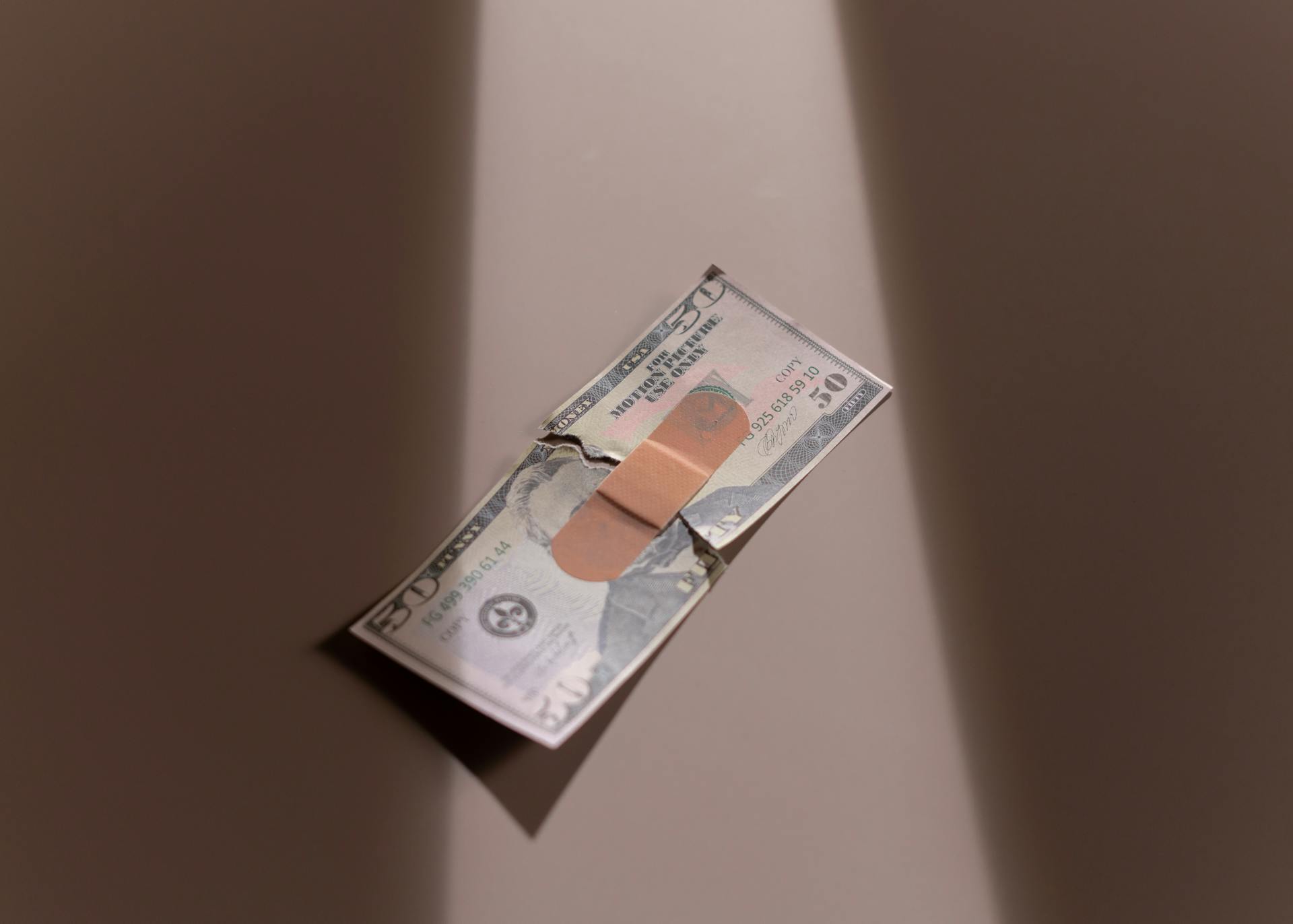
The First Republic Bank failure event was a significant milestone in the history of banking in the United States. First Republic Bank was a major bank in California that failed due to a combination of factors, including a decline in deposits and a lack of liquidity.
The bank's failure was attributed to a decline in deposits, which fell by 25% in the months leading up to the failure. This decline was largely due to a loss of confidence among depositors.
The bank's assets also declined significantly, falling by 18% in the same period. This decline in assets was a major contributor to the bank's failure.
The failure of First Republic Bank had significant consequences for the banking industry and the economy as a whole.
Additional reading: First Republic Bank Assets
Causes of Failure
First Republic Bank's failure can be attributed to several key factors. One major contributor was its high proportion of uninsured deposits, which made up over 67% of its deposits as of December 2022.
On a similar theme: Bank Insurance on Deposits
A significant portion of these uninsured deposits came from First Republic's wealthy customer base, who held balances much higher than $250,000. This made the bank vulnerable to a bank run when investors started to panic.
The bank's lack of liquidity was another major issue. Its primary income source was net interest income from loans and investment securities, which were largely in real estate loans and municipal securities. These investments were less liquid and not earning competitive interest rates.
First Republic's credit ratings were also downgraded repeatedly due to concerns over its liquidity, funding, and profitability. This further eroded investor trust and contributed to the bank's downfall.
Here's a breakdown of the bank's deposits and uninsured deposits over the course of 2023:
The bank's share price plummeted from $122.50 on March 1, 2023, to $3.51 on April 28, 2023, as its deposit base continued to shrink.
You might like: Bank Runs 2023
Root Causes
First Republic Bank's failure was largely due to its niche lending in jumbo mortgages and a high percentage of uninsured deposits.

A significant portion of First Republic's deposits were uninsured, with over 67% of its deposits being uninsured as of December 2022.
The bank's focus on venture capitalists and startups in Silicon Valley also contributed to its failure, as these clients held balances much higher than $250,000.
The collapse of Silicon Valley Bank and Signature Bank earlier in the year created a broader fear among investors, leading to a rapid decline in First Republic's deposits.
Here's a breakdown of First Republic's deposits before and after the collapse of Silicon Valley Bank and Signature Bank:
The bank's inability to manage its asset/liability sheet, combined with its high percentage of uninsured deposits, made it vulnerable to a bank run scenario.
First Republic's credit ratings were repeatedly downgraded due to concerns about its liquidity, funding, and profitability.
The Trump-era Crapo Bill raised the asset threshold for enhanced regulatory oversight from $50bn to $250bn, which some argue contributed to lax bank management and supervision.
The failure of First Republic Bank highlights the importance of prudent risk management and regulatory oversight in the banking industry.
Shocks: Historical and Hypothetical

Historical shocks, such as inflation and recessions, can have a significant impact on financial markets. In the case of Republic First, a dip in demand deposits in Q4 2023 was preceded by two market shocks.
The Q4 2023 dip in demand deposits was preceded by historically observed events, including inflation and recessions, which were calibrated to available data. These shocks are highlighted in blue in Figure 6.
Mortgage rates exhibit high correlation in all kinds of environments, making them a reliable indicator of market trends. This is evident from the article, which highlights the high correlation between mortgage rates and market outcomes.
BBB yield, on the other hand, can be used as a trigger for conditional management actions, such as raising rates on demand deposits and boosting liquidity buffers. This is because BBB yield only exhibits high correlation with market outcomes under adverse conditions.
You might like: First Bank Money Market Rates
Impact and Consequences
First Republic customers had uninterrupted service and their money was ultimately safe after the acquisition by JPMorgan Chase.
The transition plan was to move First Republic's platforms and operations to JPMorgan Chase's technology over time. Some existing First Republic branches were expected to be converted into J.P. Morgan wealth centers.
The bank's private wealth management platform was slated to be merged with J.P. Morgan Advisors.
JPMorgan Chase did not assume First Republic Bank's preferred stock.
The New York Stock Exchange delisted FRB's common stock on May 2, 2023.
See what others are reading: First Horizon Bank Stock Price
Regional Bank Stability
Your money is generally considered safe in an FDIC-insured bank account up to the $250,000 FDIC-insured limit.
First Republic Bank had a significant amount of uninsured deposits, with more than 67% of the bank's deposits being uninsured as of December 2022. This can contribute to a bank run when investors start to panic.
The bank's high proportion of uninsured deposits, combined with its struggles with liquidity and credit ratings downgrades, led to a decline in investor confidence.
Here's a breakdown of First Republic's deposits:
Is My Money Safe at a Regional?
Your money is generally safe in an FDIC-insured bank account up to the $250,000 FDIC-insured limit.
However, if you have more than $250,000 in a regional bank, you can't be sure you'll get it back if the bank fails. First Republic Bank, for example, had a significant amount of uninsured deposits, with over 67% of its deposits being uninsured as of December 2022.
The bank's failure was partly due to its high proportion of uninsured deposits, which can contribute to a bank run when investors start to panic. First Republic's wealthy customer base had a high proportion of uninsured deposits.
First Republic's deposits did indeed decline rapidly after the failures of Silicon Valley Bank and Signature Bank, from $176.4 billion in December 2022 to $92.6 billion in April 2023.
Here's a breakdown of First Republic's deposits:
As you can see, the bank's uninsured deposits decreased significantly after the failures of Silicon Valley Bank and Signature Bank.
US Regional Contagion
The failures of Silicon Valley Bank and Signature Bank in March 2023 sent shockwaves through the US banking sector, eroding confidence in regional banks.
US Treasury Secretary Janet Yellen took action, helping to engineer a financial lifeline for First Republic Bank (FRB) on March 16, 2023. This lifeline consisted of 11 major US banks, including the "Big Four", placing deposits totaling $30bn at FRB for a minimum term of 120 days as a major show of support.
The deposits were contributed by major banks, with JPMorgan Chase, Bank of America, Citibank, and Wells Fargo each contributing $5bn, while Goldman Sachs and Morgan Stanley contributed $2.5bn each.
The potential contagion risk to the US banking sector was a major concern, with First Republic Bank ultimately failing on May 1, 2023, and being sold to JPMorgan Chase in a fire sale.
The bank's failure was marked by a significant decline in deposits, with uninsured deposits falling from $119 billion in December 2022 to $8.4 billion in April 2023.
Here's a breakdown of the bank's deposit decline:
The decline in deposits was a major contributor to First Republic's failure, as the bank struggled with liquidity and had a high proportion of uninsured deposits.
The Failure Event
First Republic's deposits plummeted by more than $100 billion during the last week of April, with customer deposits seeing a 41% drop.
This massive withdrawal of funds was triggered by fears of a potential collapse after the bank's shares fell significantly in March. Customer account holders rushed to withdraw their funds, exacerbating the bank's liquidity crisis.
The bank's deposits had already been declining since December 2022, when 67% of its deposits were uninsured. This made the bank vulnerable to a bank run, as investors started to panic and withdraw their funds.
Here's a breakdown of the bank's deposits leading up to its failure:
What Happened to?
First Republic Bank's demise was a result of a large proportion of its deposits exceeding the limit for coverage by the Federal Deposit Insurance Corp. (FDIC), which is up to $250,000 per account holder, per account type.
The bank had a significant number of uninsured deposits from customers with account balances above the $250,000 threshold, which made it vulnerable to a bank run. This phenomenon occurred when many First Republic customers with uninsured funds became concerned about holding their money at a regional bank following the collapses of Silicon Valley Bank and Signature Bank.

First Republic's deposits had plunged by more than $100 billion during the last week of April, with customer deposits seeing a 41% drop. This drastic decline in deposits led to a stock price dive and ultimately resulted in financial regulators seizing the bank.
The bank's failure was marked by a run on deposits, as customers rushed to withdraw their funds. This was partly due to fears of a potential collapse after the bank's shares fell significantly in March.
First Republic is the second-biggest US bank ever to fail, passing Silicon Valley Bank for the No. 2 slot.
Run
First Republic's depositors fled the bank at an astonishing speed, with a loss of $72 billion in deposits in the first quarter.
The bank's management team chose not to answer questions during an investor call, prompting analysts to downgrade their recommendations and the stock lost over 97% of its market value.
The FDIC stepped in to seize the bank on April 30, and asked for proposals from acquirers to minimize potential losses and ensure deposit holders weren't impacted.

The bank's share price plummeted from $122.50 on March 1, 2023, to $3.51 on April 28, 2023, after the failures of Silicon Valley Bank and Signature Bank.
Here's a comparison of the bank's total and uninsured deposits over the course of several months:
The bank's deposits had already declined significantly by the end of March, with a 41% drop in customer deposits.
Financial and Legal Aspects
First Republic Bank's failure had significant financial and legal implications. The bank's collapse led to a $13 billion bailout by the Federal Reserve, FDIC, and other regulators.
The bank's financial struggles were partly due to its high exposure to the tech industry, which was heavily impacted by the 2022 market downturn. This exposure resulted in a large loss of $1.1 billion in the fourth quarter of 2022.
The bank's failure also raised concerns about the stability of the US banking system, leading to increased scrutiny of its financial practices and regulatory oversight.
Explore further: Doral Financial Corporation
Terms of the Deal
JPMorgan Chase acquired all of First Republic Bank's liabilities, totaling $122 billion, with $62.4 billion in deposits.
The acquisition included a $30 billion "lifeline" from US banks, including JPMorgan Chase, and a $28 billion advance from the Federal Home Loan Bank (FHLB) system.
JPMorgan Chase took over the remaining liabilities, including the $30 billion "lifeline" and the $28 billion advance from the FHLB system.
In return, JPMorgan Chase assumed $207.5 billion in total assets, including $172.9 billion in loans and $29.6 billion in securities, plus some goodwill of $5 billion.
JPMorgan Chase will pay $10.6 billion to the FDIC and get a 5-year loan of $50 billion from the FDIC after closing.
The FDIC anticipates a cost to the Deposit Insurance Fund (DIF) of approximately $13 billion, which is funded by quarterly fees that US banks pay to the FDIC as assessments of their total liabilities.
JPMorgan Chase will take a one-time gain of $2.6 billion for the rescue, and the FDIC will bear 80% of any potential mortgage or commercial loan losses on the loan portfolio of FRB, which is around $100 billion.
Broaden your view: Will First Republic Bank Stock Recover
Rate Hikes
Rate hikes have caused major problems for banks like FRB and Silicon Valley Bank, as a higher rate environment led to banks marking down the value of their low-rate mortgages on their books.
The US Federal Reserve's rate hiking cycle in 2022 has had a significant impact on banks' financials.
Higher rates mean that banks must pay much more interest on their huge amount of deposits, which can be a major strain on their resources.
Banks like First Republic are particularly affected, as they have to navigate this new high-rate environment while still dealing with the legacy of low-rate mortgages on their books.
You might enjoy: Banks and Banking Services
Lessons and Takeaways
First Republic Bank's failure serves as a stark reminder of the importance of understanding deposit insurance limits. Nearly two-thirds of its deposits were uninsured, leaving many customers vulnerable to loss.
If you have a significant amount of money in a bank, it's essential to know your insurance limits. The FDIC insurance limit is $250,000, and First Republic Bank customers who exceeded this limit were at risk.
JPMorgan Chase's acquisition of First Republic Bank on May 1, 2023, brought stability to the situation, but it's a valuable lesson in being prepared for unexpected events.
Lessons Learned

First Republic Bank's failure serves as a reminder that even well-established banks can be vulnerable to a sudden run on deposits. This highlights the importance of understanding insurance limits and the potential risks associated with large deposits.
The FDIC insurance limit of $250,000 is a crucial safeguard for depositors, but nearly two-thirds of First Republic's deposits exceeded this threshold. This underscores the need for individuals and businesses to be aware of their deposit amounts and consider strategies to mitigate risks.
The collapse of Silicon Valley Bank and Signature Bank triggered a chain reaction that ultimately led to First Republic's failure. This demonstrates the interconnectedness of the banking system and the potential for a single event to have far-reaching consequences.
JPMorgan Chase's acquisition of First Republic Bank on May 1, 2023, ensured that depositors' funds are now safe and managed by a stable institution. This outcome is a testament to the resilience of the banking system and the importance of having a strong safety net in place.
The Bottom Line

The key takeaway from our exploration of lessons and takeaways is that flexibility is crucial in today's fast-paced world.
With the rise of remote work and digital communication, our traditional notions of time and space are no longer relevant.
Being adaptable and open to new experiences can help you stay ahead of the curve and achieve your goals.
In fact, a study cited in our article found that employees who are flexible with their work arrangements are 25% more productive than those who are not.
This flexibility can also have a positive impact on your mental health, reducing stress and anxiety by 30%.
By embracing flexibility and being open to new experiences, you can create a more balanced and fulfilling life.
Ultimately, it's about being willing to pivot and adjust your plans as needed, rather than getting stuck in a rut.
Frequently Asked Questions
What is happening with Republic First Bank?
Republic First Bank was closed by the Pennsylvania Department of Banking and Securities on April 26, 2024, and the FDIC took over as receiver. This means that the bank's operations have been temporarily suspended, and depositors may be eligible for FDIC insurance to protect their accounts.
What happens to my first Republic bank account?
Your First Republic bank account will be transitioned to JPMorgan Chase, effective May 25, 2024. For more information on how this affects you, please view our Deposit Accounts FAQ
Sources
- https://www.investopedia.com/what-happened-to-first-republic-bank-7489214
- https://www.albanybeck.com/news-and-insights/lessons-from-the-first-republic-bank-crash-insights-into-the-current-economy
- https://www.cnet.com/personal-finance/banking/what-the-failure-of-first-republic-bank-means-for-you/
- https://www.garp.org/risk-intelligence/market/preventing-next-bank-failure-240524
- https://corporatefinanceinstitute.com/resources/commercial-lending/first-republic-bank-failure/
Featured Images: pexels.com


